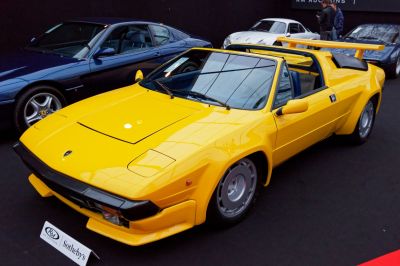 1996 De Tomaso Mangusta II Dimensions, Size & Specs
1996 De Tomaso Mangusta II Dimensions, Size & SpecsMeasurements of the 1996 De Tomaso Mangusta II, engineered for optimal performance and comfort
| Dimensions | |
|---|---|
| Length: | 4275 mm168.3 in14.0 ft |
| Width: | 1830 mm72.0 in6.0 ft |
| Height: | 1100 mm43.3 in3.6 ft |
| Weight Specifications | |
| Curb Weight: | 1185 kg2612 lbs |
The De Tomaso Mangusta II, produced from 1996 to 2001, is a striking cabriolet that blends classic Italian design with compact sporty dimensions tailored for enthusiasts who value both style and performance. Measuring 4275 mm (168.3 inches) in length, 1830 mm (72 inches) in width, and standing at just 1100 mm (43.3 inches) tall, the Mangusta II presents a low-slung and aggressive presence on the road, typical of high-performance sports convertibles of its era. The relatively light curb weight of 1185 kg (2613 lbs) enhances its nimbleness and driving dynamics, contributing to sharp handling and an engaging open-air driving experience. Its compact size situates it comfortably within the classic sports cabriolet segment, offering a design that is manageable for both city and spirited driving without sacrificing road presence. As a successor to the original Mangusta, the Mangusta II revives the iconic nameplate with modern refinements while maintaining the legacy of Italian craftsmanship and exclusivity. This generation remains an appealing choice for collectors and drivers attracted to rare and stylish convertible sports cars from the 1990s automotive landscape.
Discover the standout features that make the 1996 De Tomaso Mangusta II a leader in its class
Have a question? Please check our knowledgebase first.
The De Tomaso Mangusta II, produced between 1996 and 2001, measures 4275 mm (168.3 inches) in length, 1830 mm (72.0 inches) in width, and 1100 mm (43.3 inches) in height. These dimensions contribute to its sleek, low-slung sports car appearance, emphasizing both style and aerodynamic efficiency. The relatively compact length and width make it a manageable car, while its low height underlines its sporty profile.
The curb weight of the De Tomaso Mangusta II is 1185 kg (approximately 2613 lbs). This weight is quite light for a cabriolet sports car of its period, which positively influences its agility, acceleration, and braking capabilities. A lower curb weight means improved power-to-weight ratio, enhancing overall driving dynamics and making the car more responsive and fun to drive.
Yes, the De Tomaso Mangusta II generally fits into a standard residential garage. With a length of 4275 mm (168.3 inches) and a width of 1830 mm (72.0 inches), it is within the typical garage size allowance. Most single-car residential garages have a minimum length of around 5,000 mm (196.9 inches) and widths of about 2,400 mm (94.5 inches), so the Mangusta II will comfortably fit with sufficient space for opening doors and maneuvering around the vehicle.
With a width of 1830 mm (72.0 inches), the De Tomaso Mangusta II is comparable to many late 1990s sports cabriolets, which typically ranged from about 1750 to 1850 mm in width. This width allows for a stable road presence without being excessively wide, ensuring good handling characteristics while still being practical for everyday driving and parking.
The height of the Mangusta II is 1100 mm (43.3 inches), suggesting it is a very low-profile sports car. While exact ground clearance was not specified, cars with such low height typically have ground clearances around 100-120 mm (3.9-4.7 inches). This low stance improves aerodynamic performance and handling but requires careful driving over speed bumps or uneven surfaces to avoid undercarriage damage.
The Mangusta II is generally more compact and modern compared to its iconic predecessor, the original Mangusta produced in the late 1960s and early 1970s. The original Mangusta was longer, measuring roughly 4290 mm (169 inches) in length but heavier and bulkier. The 1996 Mangusta II's design aimed to capture the essence of the original while optimizing for reduced weight (1185 kg vs. heavier older models) and a more streamlined, cabriolet form for modern driving conditions and style preferences.
Compared to contemporaries like the Ferrari F355 Spider and Porsche 911 Cabriolet (996 generation), the Mangusta II is somewhat similar in footprint but generally lighter. The F355 Spider measured about 4270 mm (168.1 inches) long and weighed about 1450 kg, making the Mangusta II slightly heavier in length but considerably lighter in weight at 1185 kg. The Porsche 911 Cabriolet of that era was roughly 4340 mm (170.9 inches) long and weighed around 1500 kg. The Mangusta II’s lighter weight and comparable dimensions give it a unique blend of nimbleness and classic styling.
The De Tomaso Mangusta II is a two-seater cabriolet, designed primarily for driver and passenger with a focus on sporty driving experience rather than spaciousness. Given its compact length of 4275 mm and low height of 1100 mm, interior space is tight but ergonomic, emphasizing cockpit feel and close driver engagement with controls. The cabriolet layout enhances open-air driving pleasure, although rear passenger seating is not available.
Its compact size combined with a very low height of 1100 mm (43.3 inches) significantly enhances the Mangusta II’s aerodynamic profile, reducing drag and improving stability at high speeds. The sleek, low design minimizes frontal area, allowing for smoother airflow over the body which aids in fuel efficiency and driving stability. This low center of gravity also contributes positively to cornering performance, making it a nimble and fast sports cabriolet on the road.
Thanks to its relatively compact dimensions—4275 mm (168.3 inches) in length and 1830 mm (72.0 inches) in width—and light weight of 1185 kg, the Mangusta II is fairly practical for urban use. Its size allows easier parking in tighter spaces compared to larger sports cars or grand tourers, while the cabriolet design can make it enjoyable for city cruising. The low height might require caution on uneven roads or steep driveways, but overall, it balances sporty appeal with manageable city usability.
Discover similar sized cars.

| Production: | 1982-1988 |
|---|---|
| Model Year: | 1982 |
| Length: | 4330 mm170.5 in |
| Width: | 1880 mm74.0 in |
| Height: | 1140 mm44.9 in |
